Sleeker Tiguan combines assets of sedan, SUV
By John Gilbert
Back when the Tiguan came out as a new idea for a utility vehicle from Volkswagen, the conservative builder of dependable compact cars like the Golf, Jetta, upscale to the Passat, and the venerable old
Microbus, it seemed to be a curious notion.
Little did we all realize the craze that would follow, with consumers throughout the U.S., and later all around the auto-buying world clamoring for more SUVs until they are now threatening to squeeze normal cars out of the marketplace.
I recall those first Tiguans, because they were loaded with utility, but they were sort of tall and squarish vehicles. Years later, VW added a longer version of the Tiguan for more room and more occupants. When that came out, I appreciated the shorter and more agile shorter version — just because in nearly all circumstances, I prefer the more compact length, but having room for a third row of seats was a family feature.
When the 2023 version of the Tiguan arrived at my house in Duluth, Minnesota, for a week-long test, I first thought it was a wagon version of the Passat or Jetta. No longer was it taller and squarish, but seems to be lower and sleeker in a modernized way that made it enticing to drive. I had to keep rethinking that it was, indeed, a Tiguan, with the benefits of driving agility and three rows of seats that somehow fit inside.
As usual, Volkswagen has made evolutionary moves with the Tiguan rather than revolutionary changes. For styling, the redesigned exterior is subtle, with a new wraparound grille that encompasses the LED headlights as part of its wraparound plan. The foglights are LEDs, too, for maximum brightness and sharp visual cutoff of that brightness.
Otherwise, VW brought the Tiguan up to contemporary elite status by revising the interior with improved seats, a restyled dashboard with an enlarged information display that can be changeable to show you climate, audio, and all other useful information for your drive.
Under the hood, the tried and true Volkswagen 2.0-liter gas 4-cylinder has taken inspiration from the GTI, that timeless hot rod in a small compact that has enthralled performance buyers and drivers for decades. Refining that engine over the years has pretty well perfected it, and adding a turbocharger means you have 184 horsepower at your disposal, with the potent power of 221 foot-pounds of torque, and an 8-speed transmission moving the vehicle with quickness and agility.
That doesn’t mean the Tiguan is a hot-rod, because it is significantly heavier than the Golf or GTI, but it does move well for its size. Volkswagen does a lot better with its technical refinement than it does with its nicknames, in my opinion, however.
The car I tested was the “Tiguan 2.0T SE R-Line Black” model, which would imply it was probably painted black. But no, it was a bright Opal White Pearl paint, which means to be fully accurate you should say it’s a 2.0T R-Line Black model in white. The Black version has blacked out painted grille and alloy wheels, which add distinctly sporty appearance, while the R-Line adds some performance enhancements and trim upgrades.
Those refinements boost the base price of $32,950 up to $34,640, which is a bargain when you evaluate all it has with its competition. All the new safety gizmos are included, such as brake assist, electronic stability control, electronic differential lock, blind-spot assist, lane-keeping assist, pedestrian alert and prevention, stop-start, and a hill-holding concept that prevents you from rolling when you’ve stopped on a steep grade.
The overriding safety of the Tiguan is bolstered by the strong German tradition of build quality and solid feel, something which simply gives you the feeling you’re encased in a solid shell against intrusions by other vehicles. The steering quickness and firm suspension is further confidence-inspiring.
The firm comfort of the front buckets and the 3-person second row still leave you surprised that there’s a fold-down third-row seat that is best limited to youngsters, even though teens or adults would be comfortable back there for short hauls.
Al those features are enough to keep you checking the name on the hatch lid to make sure you have a Tiguan, and not a Golf or GTI that outgrew its livery. And who knows? Maybe next year they will come out with a Tiguan White model that comes in black.



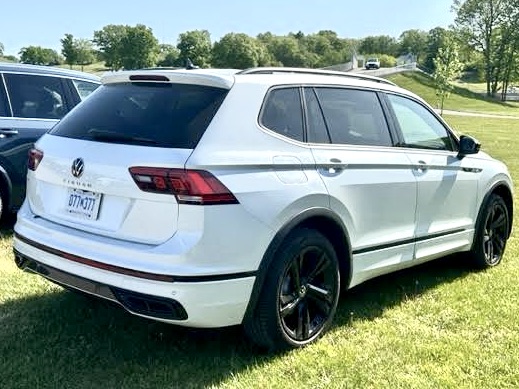
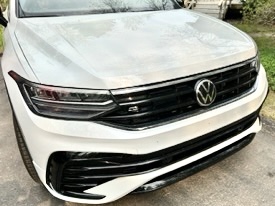
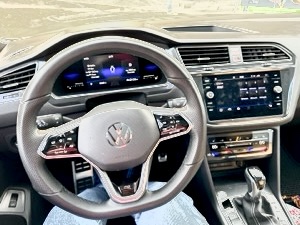
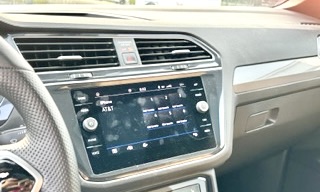
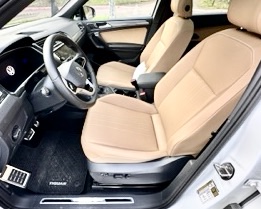
 John Gilbert is a lifetime Minnesotan and career journalist, specializing in cars and sports during and since spending 30 years at the Minneapolis Tribune, now the Star Tribune. More recently, he has continued translating the high-tech world of autos and sharing his passionate insights as a freelance writer/photographer/broadcaster. A member of the prestigious North American Car and Truck of the Year jury since 1993. John can be heard Monday-Friday from 9-11am on 610 KDAL(www.kdal610.com) on the "John Gilbert Show," and writes a column in the Duluth Reader.
John Gilbert is a lifetime Minnesotan and career journalist, specializing in cars and sports during and since spending 30 years at the Minneapolis Tribune, now the Star Tribune. More recently, he has continued translating the high-tech world of autos and sharing his passionate insights as a freelance writer/photographer/broadcaster. A member of the prestigious North American Car and Truck of the Year jury since 1993. John can be heard Monday-Friday from 9-11am on 610 KDAL(www.kdal610.com) on the "John Gilbert Show," and writes a column in the Duluth Reader.